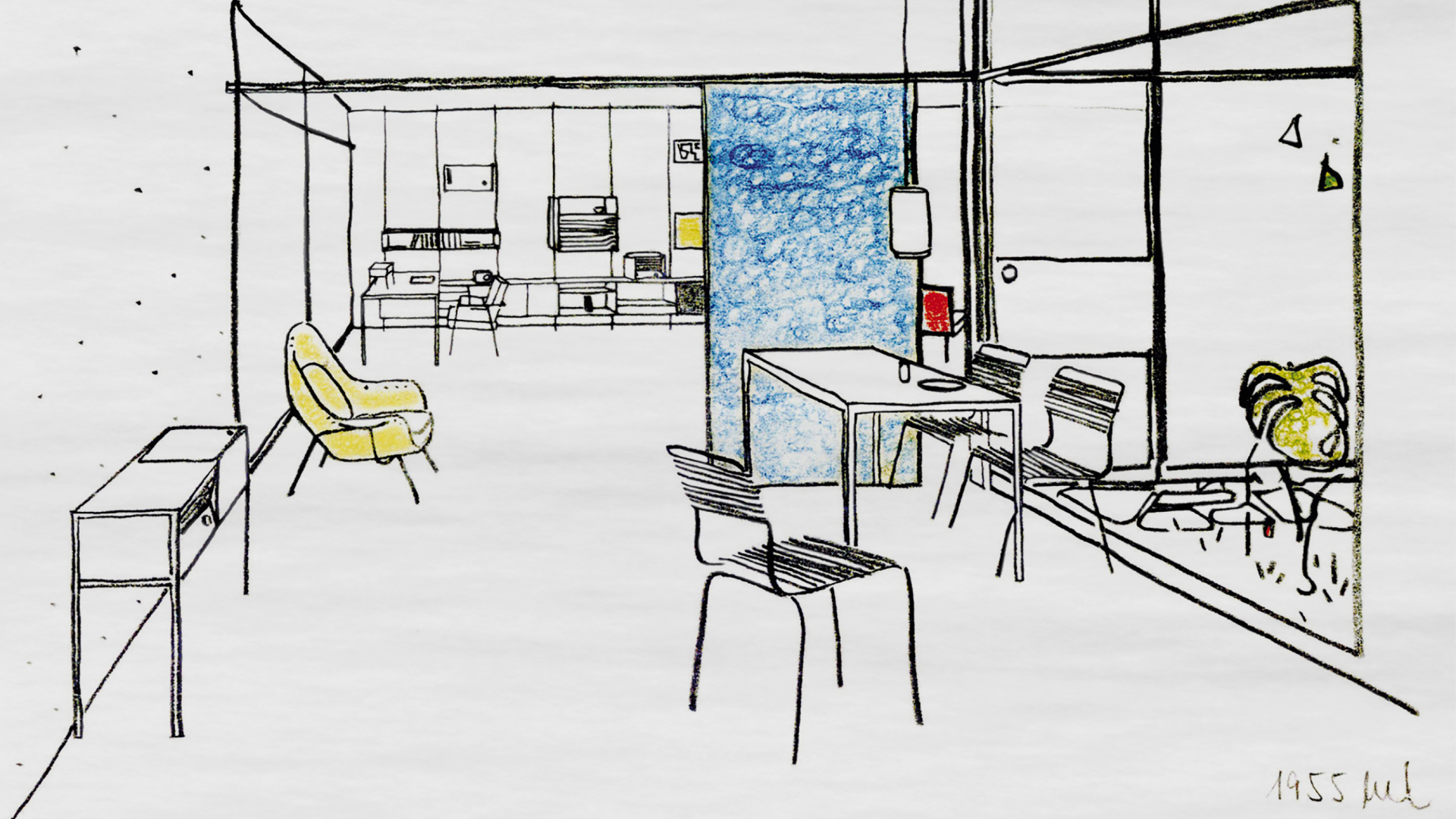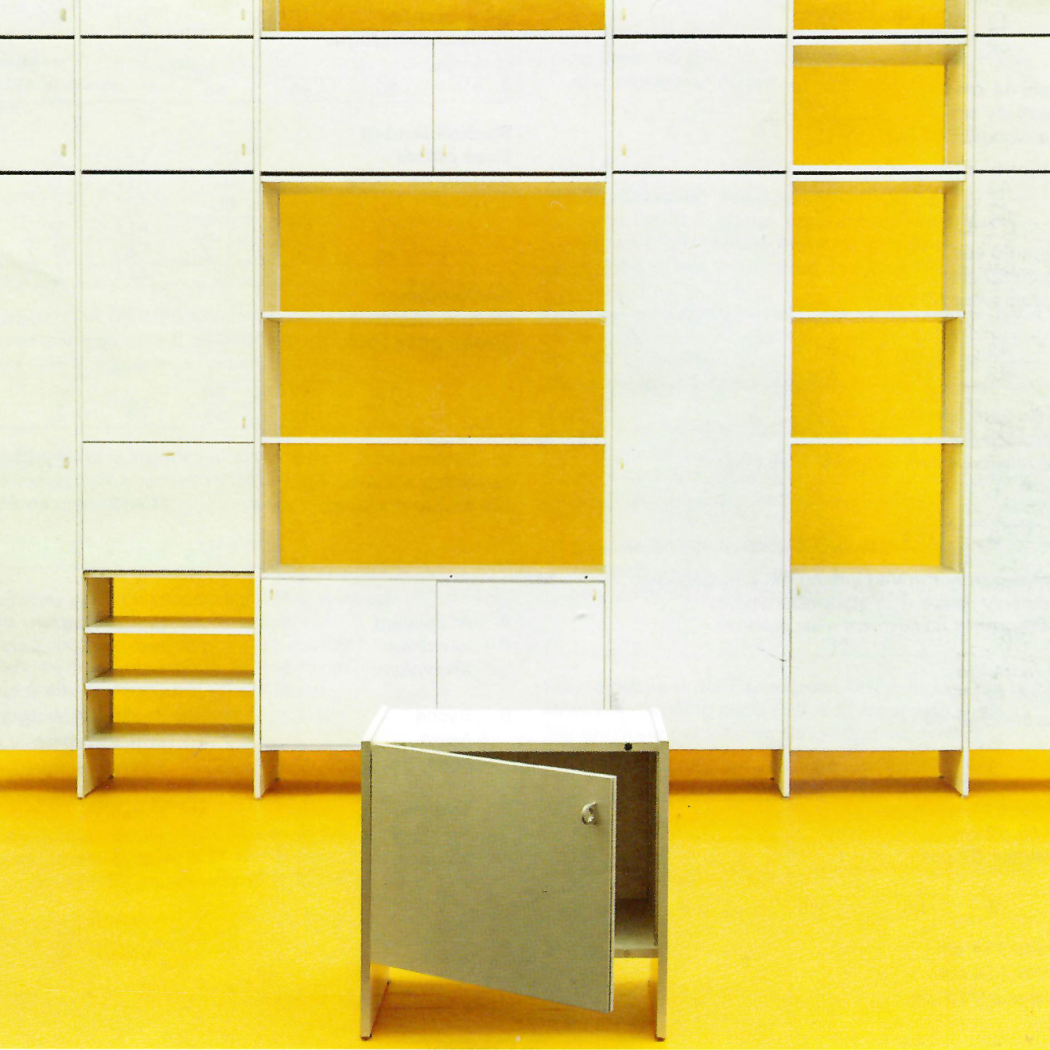1913
Niels Wiese Vitsø (pronounced ‘vit-sue’), co-founder, born Aarhus, Denmark, 13 February. Inevitably the number 13 becomes Vitsœ’s lucky number.

1931
Otto Zapf, co-founder, born Rossbach, Czechoslovakia, 10 August.
1932
Dieter Rams, industrial designer, born Wiesbaden, Germany, 20 May. Learns carpentry at an early age from his grandfather, a master carpenter.

1947
Dieter Rams studies architecture and interior design at Wiesbaden School of Arts and Crafts, Germany.
1955
Dieter Rams joins the German electrical products company, Braun, as an interior architect. He presents a sketch to modernise Braun’s interiors. On the back wall can be seen the first notion of a track-based, wall-mounted, storage system.

1957
Otto Zapf visits Dieter Rams at Braun and asks Rams to design furniture for Zapf’s father’s furniture-making company.
When Rams seeks the permission of Braun’s director, Erwin Braun, to work for another company, the instinctive answer was: “Yes! It will help the market for our radios.”
Rams develops designs for a flat-pack modular home storage system: 571 Montage System (originally RZ 57).
Zapf meets Danish furniture dealer Niels Vitsø at Cologne Furniture Fair, Germany.

1958
Otto Zapf introduces Rams to Niels Vitsø.
1959
Niels Vitsø and Otto Zapf found the company Vitsoe+Zapf on 4 September to realise the furniture designs of Dieter Rams. German artist, Günther Kieser, represents Niels Vitsø intertwined with a chair for the launch poster.

1960
606 Universal Shelving System (originally RZ 60) is launched as a wall-mounted storage solution.

1961
Dieter Rams is appointed head of product design at Braun.
Mark Adams, Vitsœ managing director, born Ipswich, England, 28 February.

1962
620 Chair Programme (originally RZ 62) and 621 Table are launched – the first and second Vitsœ products of 1962 – therefore 62-0 and 62-1. (Photographs by Ingeborg Kracht-Rams)


1967
Otto Zapf leaves ‘Vitsoe+Zapf’.
Rams marries Ingeborg Kracht-Rams (1931-2022), a photographer for both Braun and Vitsœ. The pair remained together for over 50 years until Kracht-Rams’s death at the age of 91.

1968
Dieter Rams appointed director of product design at Braun.
Rams awarded an honorary RDI (Royal Designer for Industry) by the Royal Society of Arts, London, for distinguished furniture and light-engineering designs.
1969
‘Vitsoe+Zapf’ becomes Wiese Vitsœ GmbH & Co. Niels Vitsø changes ø in his own name – and the ‘oe’ in the company’s name – to an ‘œ’ ligature, in order to appeal to a wider European audience.
The names of Vitsœ products change from RZ xx to take their names from their year of introduction, and the order in which they first appeared on the market, beginning the count at zero: 606 Universal Shelving System, 620 Chair Programme and more.
Vitsœ’s logo and corporate identity are developed by graphic designer Wolfgang Schmidt using Adrian Frutiger’s Univers typeface.

1970
Vitsœ’s first showroom opens on Kaiserhofstraße in Frankfurt, Germany. The company enters a phase of accelerated product-development and builds a dealership network in Germany, Switzerland, the Netherlands and Denmark.
620 Chair Programme (RZ 62) accepted into permanent collection of Victoria & Albert Museum, London.

1973
The 620 Chair Programme is granted artistic copyright protection by the German Federal Court following legal action regarding plagiarism. The court substantiated: “The design of this chair is a personal, original creation of highly aesthetic value.”

1975(-85)
Concerned by the state of the world around him, Dieter Rams develops his ‘Ten principles for good design’.

1976
Dieter Rams delivers a prescient speech in New York titled ‘Design by Vitsœ’ in which he asserts his commitment to responsible design. Niels Vitsœ is sufficiently proud of coverage in The New York Times to use his own handwriting and signature on the subsequent Vitsœ newsletter.

1984
Dieter Rams and Niels Vitsœ grant a licence to Italian furniture manufacturer, De Padova, to produce an aluminium version of the 606 Universal Shelving System.

1985
Mark Adams discovers Vitsœ’s 606 Universal Shelving System at its UK launch in London interiors shop, Reflex.

1986
Mark Adams meets Niels Vitsœ, Dieter Rams and Ingeborg Kracht-Rams in Frankfurt.
Later that year Adams establishes Vitsœ UK Ltd. A showroom opens in Butler’s Wharf, London, near the Design Museum (under construction).

1987
Vitsœ UK Ltd begins manufacturing shelves for the 606 Universal Shelving System in the United Kingdom. Showroom moves to Tyers Gate, London.

1989
Vitsœ’s UK showroom moves to Bermondsey Street, London.
1993
Mark Adams invited to become managing director of Wiese Vitsœ on the retirement of Niels Vitsœ.
1995
Vitsœ UK Ltd becomes Vitsœ Ltd. The corporate seat and production of Rams’s furniture is moved from Germany to the United Kingdom. Production relocates to Islington, London. Wiese Vitsœ closes.
Niels Vitsœ dies, Copenhagen, Denmark, aged 82.
Dieter Rams grants a licence to German furniture manufacturer, sdr+, to begin production of his furniture.
1997
Rams retires from Braun.
1998
Vitsœ expands sales to the United States via retailer Moss in New York.

1999
Introduction of floor-plate stillages for transport between multiple suppliers, and reusable cabinet bags for delivery to customers – with zero packaging waste.


2003
Vitsœ launches bespoke software planning tool to allow online planning service of shelving systems worldwide.

2004
Vitsœ opens its first London shop on Wigmore Street.
606 Universal Shelving System accepted into permanent collection of Museum of Modern Art, New York.


2005
Vitsœ’s production building relocates to Camden, London.


2008
Vitsœ cited in academic paper ‘Towards a sustainable industrial system’ by University of Cambridge Institute for Manufacturing and Cranfield University.
2008(-11)
‘Less & More: The Design Ethos of Dieter Rams’ exhibited in Osaka and Tokyo, Japan; Seoul, South Korea; London’s Design Museum; and SFMOMA, San Francisco.

2009
Vitsœ’s first US shop opens on Bond Street, New York.
Vitsœ’s London shop moves to Duke Street.


2011
Vitsœ is invited to be founder member of Centre for Industrial Sustainability, University of Cambridge.
2012
Dieter Rams terminates licence with sdr+, Germany. sdr+ production of Rams-designed furniture ceases.
2013
Vitsœ becomes the exclusive worldwide licensee of Dieter Rams’s complete collection of original furniture designs.
Vitsœ ceases distribution via third-party dealers. All sales are now direct to the end-user, worldwide.
620 Chair Programme and 621 Table are re-engineered and relaunched by Vitsœ and Dieter Rams.
Vitsœ shop opens on Türkenstraße, Munich, Germany.
Vitsœ invites customers to subscribe to a mini-bond to raise funds for future expansion.




2014
Vitsœ buys land in Royal Leamington Spa, UK, as location for new production building.

2016
Construction of new Vitsœ production building begins in Royal Leamington Spa, UK.
Dieter Rams terminates licence with De Padova, Italy, for aluminium version of the 606 Universal Shelving System.

2017
Vitsœ shop opens on West 3rd Street, Los Angeles, USA.

Vitsœ production moves from London to Royal Leamington Spa, UK.


2018
‘Rams’, a documentary feature-film by American filmmaker Gary Hustwit – with soundtrack by Brian Eno – is released worldwide.
Vitsœ’s New York shop moves to West 8th Street, New York, USA.
An important court judgment is granted for the 606 Universal Shelving System in which the design of the metal shelf is referred to as “extremely reduced, clear and calm” with “no design elements that cause unrest” and the “highly individually designed shelves consist solely of a thin metal sheet, giving the impression of a flowing lightness.” This became known as the ‘lyrical judgment’.


2019
Vitsœ’s London shop moves to Marylebone Lane, London, UK. Dieter Rams’s presence causes an attraction.

The Strong collection, an extensive lifelong collection of Braun products assembled by graphic designer Tom Strong is donated to Vitsœ for display at its production building for the benefit of future design students.

2021
Vitsœ shop opens on Regent Street, Royal Leamington Spa, UK.
De Padova ceases production of the aluminium version of the 606 Universal Shelving System.

2022
Vitsœ cited in ‘The Sufficiency-Based Circular Economy – an analysis of 150 Companies’ by research publisher, Frontiers.
Ingeborg Kracht-Rams – Rams’s wife of over 50 years – dies, aged 91.
2023
The Supreme Court of Cassation in Italy recognises the 606 Universal Shelving System as a work of art. It is copyright-protected on behalf of Rams and Vitsœ.
Today
With a growing international team Vitsœ delivers directly to more than 90 countries from its UK production building. The quest continues to encourage more people to buy less furniture – and to make it last longer.
